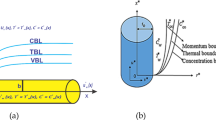Abstract
In many supersonic inlets, several oblique shock waves are followed by a terminal normal shock wave. The normal shock-wave/turbulent boundary-layer interaction is critical with respect to its influence on the development of boundary layer throughout the subsonic diffuser and the total pressure recovery at the engine face. In the current study, the bump-type inlet was designed for two oblique shock waves and a normal shock wave. In addition, a porous surface was installed underneath the root of the normal shock wave. The effect of flow control on the interaction between the normal shock wave and turbulent boundary layer in supersonic inlets by using the bleeding system was investigated numerically and was evaluated with respect to the inlet performance parameters.
Similar content being viewed by others
References
M. C. Gridley and S. H. Walker, Advanced aero-engine concepts and controls, AGARD Conf. Proc. 572, 86th Symposium, Seattle, WA, USA (1996).
J. Seddon and E. L. Goldsmith, Intake aerodynamics, Blackwell Science (1999) 336–340.
P. C. Simon, D. W. Brown and R. G. Huff, Performance of external-compression bump inlet at Mach number of 1.5 to 2.0, NACA-RM-E56L19, National Advisory Committee for Aeronautics, Washington, USA (1957).
S. D. Kim, Aerodynamic design of a supersonic inlet with a parametric bump, Journal of Aircraft, 46 (1) (2009) 198–202.
Y. K. Yang, Research of bump inlet design and test, Kongqi Donglixue Xuebao/Acta Aerodynamica Sinica, 25 (3) (2007) 336–338.
J. Benson and L. D. Miller, Mach 5 turbo-ramjet inlet design and performance, ISABE Conference, Nottingham, U.K. (1991) 746–753.
C. Hirsh, Numerical Computation of Internal and External Flows, John Wiley & Sons, NY (1989) 493–594.
S. D. Kim and D. J. Song, Modified shear-stress transport turbulence model for supersonic flows, Journal of Aircraft, 42 (5) (2005) 1118–1125.
D. W. Kuntz, V. A. Amatucci and A. L. Addy, Turbulent boundary layer properties downstream of the shock wave/boundary layer interaction, AIAA Journal, 25 (1987) 668–675.
G. S. Settles, T. J. Fitzpatrick and S. M. Bogdonoff, Detailed study of attached and separated compression corner flowfields in high Reynolds number supersonic flow, AIAA Journal, 17 (6) (1979) 579–585.
D. W. Mayer and G. C. Paynter, Boundary conditions for unsteady supersonic inlet analyses, AIAA Journal, 32 (6) (1994) 1200–1206.
J. W. Slater, D. O. Davis, B. W. Sanders and L. J. Weir, Role of CFD in the aerodynamic design and analysis of the parametric inlet, ISABE-2005-1168, ISABE Conference, Munich, Germany (2005).
J. W. Slater and J. D. Saunders, Modeling of fixed-exit porous bleed systems, AIAA Journal of Propulsion and Power, 26 (2) (2010) 193–302.
S. D. Kim, A computational study on the influence of a bleed slot on the flowfield of a bump-type inlet, Journal of Mechanical Science and Technology, 29 (12) (2015) 5245–5250.
E. Loth, R. Jaiman, C. Dutton, S. White, F. Roos, J. Mace and D. Davis, Mesoflap and bleed flow control for a Mach 2 inlet, 42nd AIAA Aerospace Science Meeting, Reno, NV, USA (2004).
M. Svensson, A CFD investigation of a generic bump and its application to a diverterless supersonic inlet, defence & security, Systems and Technology, Swedish Defence Research Agency (FOI) (2008).
T. I.-P. Shih, Control of shock-wave/boundary-layer interactions by bleed, International Journal of Fluid Machinery and Systems, 1 (1) (2008) 24–32.
J. W. Slater, Improvements in modeling 90o bleed holes for supersonic inlets, AIAA 2009-0710, 47 th AIAA Aerospace and Science Meeting and Exhibit, Orlando, FL, USA Jan. 5-8 (2009) (NASA/TM-2009-215597).
N. Titchener, An experimental investigation of flow control for supersonic inlets, Ph.D. Dissertation, University of Cambridge (2013).
Author information
Authors and Affiliations
Corresponding author
Additional information
Recommended by Associate Editor Jungil Lee
Sangdug Kim is a Professor at the Department of Aircraft maintenance, Chodang University. Prior to joining the faculty at Chodang University, he was a Senior Researcher at UNISON. He earned his Ph.D. from Yeungnam University in 2000. Dr. Kim’s research interests are in the area of CFD, applied aerodynamics, and multiphase flows.
Rights and permissions
About this article
Cite this article
Kim, S.D. A numerical study on the effect of the flow control using bleeding systems in a bump-type inlet. J Mech Sci Technol 31, 5821–5828 (2017). https://doi.org/10.1007/s12206-017-1124-y
Received:
Revised:
Accepted:
Published:
Issue Date:
DOI: https://doi.org/10.1007/s12206-017-1124-y




